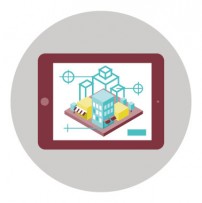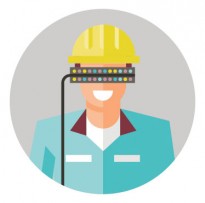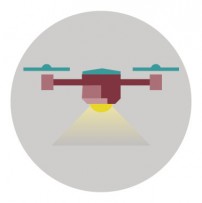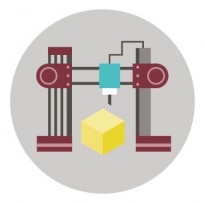 1. Building information modelling
1. Building information modelling
Take-up of Building Information Modelling (BIM) is accelerating. As Kim van Rooyen, director of global construction consultancy Turner & Townsend, says: “It isn’t just a new technology – it’s a whole new way of working. It has yet to be adopted everywhere, but within a decade it will be as integral to the construction industry as computer-aided design is now.” What makes BIM different is the way in which it enables every person involved in both design and construction to share detailed, 3D data models of every aspect of a project. It provides a way for architects, surveyors, engineers and contractors to collaborate more efficiently and avoid costly mistakes – and allows a building’s owner to make the right decisions before, during and after construction. The UK construction industry has been an early adopter and from April 2016 it will be compulsory in all public sector construction projects.
2. Robots
No longer thought of as merely a gimmick or ridiculously expensive, robots are being used to plug the skills gap, drive down costs and speed up projects. According to a recent report by Bank of America Merrill Lynch, the total global market for robots and artificial intelligence is set to reach £99 billion by 2020, and construction is going to be a key sector for this technology. To date, use of automation on construction sites has been limited, used to support basic labour or demolition. IFS global industry director, project-based industries, Kenny Ingram says: “A wealth of exciting new possibilities are coming to the forefront, my favourite being an Australian-designed machine called Hadrian, which can reportedly build a house made of 15,000 bricks in about two days. Going forward, the clear cost-saving accuracy, and health and safety benefits created by robotics will be hard for construction firms to ignore.”
 3. Visualisation and virtual reality
3. Visualisation and virtual reality
Construction is an industry where trial and error is an unacceptable approach. The first version, whether of a bridge or a building, has to be safe and functional from the get-go. It must remain so during its life cycle no matter the natural disasters or extreme human actions it may experience. Thierry Marchal, director at ANSYS, says: “Modelling inside a computer, in a virtual environment, is the only option. This becomes incredibly disruptive when it gives architects, designers and engineers the freedom to experiment with some truly staggering ideas, leading to the kind of buildings that look like gigantic pieces of art.” In the development of the new Florence train station roof, for example, virtual patterning provided analysis of the roof’s performance under different rainfall and drainage situations, the erosion patterns of its many glass surfaces, and the effects of falling rainwater on pedestrian safety.
 4. Internet of things
4. Internet of things
The growing network of the internet of things (IoT) and the resulting availability of data are being used to monitor and measure the performance of assets over a life cycle. As Dominic Thasarathar, strategist for the construction, energy and natural resources industries at Autodesk, says: “Not only does this allow for predictive maintenance and repairs on structures to avoid potential hazards, but construction companies can also learn from the data and adapt future designs which can help save money.” Johannes Petrowisch, partner account manager at industrial automation software expert COPA-DATA, adds: “The IoT is expected to ease us gently into the world of the smart city. Street lights that can automatically adjust to environmental conditions and traffic levels, or water distribution systems that can identify leaks instantaneously and shut off pipes automatically are only a few of the marvels we can expect to see more of in our cities.”
5. Lockable composite road plates
Construction is about a lot more than buildings as wider infrastructure needs to be developed and maintained. MCL Group’s lockable composite road plates could lead to a 30 per cent improvement in repair time. They allow trenches dug during roadworks to be safely covered very quickly, reopened to traffic overnight, at weekends or when work cannot be carried out instead of coning the area off. The simple interlocking composite plate system, which uses a patented locking mechanism to fasten, can be installed in minutes. According to UK government statistics, traffic hold-ups caused by road closures cost the UK economy £4.3 billion in 2013. Given the Department of Transport’s plans to fine utilities companies and councils up to £5,000 a day for leaving roadworks unmanned at evenings and weekends, this could make a massive difference to their ability to maintain the system.
6. Aerogel
New materials are making fundamental inroads to the structure of our buildings, changing our expectations of what needs to be managed. Aerogel is a synthetic porous ultralight material derived from a gel, in which the liquid component of the gel has been replaced with a gas. Aerogel can withstand very high temperatures, delivering 39 times more insulation than fibreglass. Aerogels are fantastic insulators because they limit two of the three methods of heat transfer – convection, conduction and radiation. Historically, it has been used for insulation in spacecraft and spacesuits, and in building studs to manage heat transfer. Now Origin Windows, which has exclusivity with Aerogel, is to supply it in conjunction with its windows, providing major energy savings for the life of the home – in fact a single 10mm thickness of Aerogel increases insulation by up to 67 per cent.
 7. Drones
7. Drones
Increasingly, drones provide crucial surveying information, monitor project progress against more detailed digital designs and help create 3D models. In hard-to-reach places, such as the underside of a bridge, instead of paying expensive engineers to access the asset safely, relatively inexpensive drones can be flown down to capture images for inspection immediately – often costing up to three times less than managing that process manually. Ariel inspection is another area in which drones are making their mark for surveying, site management and logistical planning. Kenny Ingram at IFS says: “Crossrail is a great example of a company currently using drones as part of its Innovate18 project, which is focused on bringing in innovative processes and technology across its operations. Drones are in regular use across many of its sites and used for activities such as crane, tower and scaffolding inspections or site planning.”
 8. 3D printing and digital off-site manufacturing
8. 3D printing and digital off-site manufacturing
Laser scanning and 3D printing are technologies that prove truly disruptive, where digital designs are broken down into components which are then manufactured by robots and 3D printers. The aim is to speed up processes and increase productivity and efficiency within projects, while reducing manufacturing and labour costs. The possibilities of 3D printing for architecture are endless. Allowing architects and engineers to construct solid objects from digital models generates a huge potential cost-saving, allowing low-income homes to be quickly erected at scale and helping governments quickly address housing shortages or provide temporary homes for refugees, for example. It reduces time, waste and cost, and can be used for anything from printing out components for a modular build or to print out a whole building. Combining it with BIM could prove transformative as much of the information necessary to create the end product will exist as a result of the design process.
9. MassMotion
As urban populations increase at an exponential rate, transport infrastructure is expected to struggle. According to Alec Milton, Director, Technical Software Group, Arup, “Crowd simulation software like Arup’s MassMotion, allows 3D modelling of pedestrian and crowd movements through proposed design structures and shows how crowd congestion is impacted by the arrival patterns of trains at interchange stations, for example. Through the software, each character has its own artificial ‘intelligence’, making unique decisions as they move from one environment to the other in real time, enabling models of stations to be developed, calibrated, and validated based on realistic passenger behaviour. This was used in the $1 billion development of Toronto’s Union Station, highlighting previously unforeseen congestion issues, allowing these to be solved before design implementation and construction, making the construction process faster and more cost effective.
10. SoundLab
Sound simulations (or auralisations) help demonstrate the impact that construction will have on the acoustic output of projects. Previously, performing arts construction projects had to factor in lengthy periods of testing, tuning and commissioning once a building was finished. According to Ian Knowles, Director, Acoustics UK, Arup, “The SoundLab has fundamentally transformed this paradigm allowing design choices to be made based on this knowledge, before construction. The technology enables you to sit in the centre of an optimised and acoustically controlled room and, listening to an ambisonic array of speakers, instantly compare and contrast the acoustics of any venue. It is also being used to model the potential impact of major infrastructure projects, like HS2, and inform the location type and optimisation of noise barrier solutions, road surface types and the route of transport links.”
